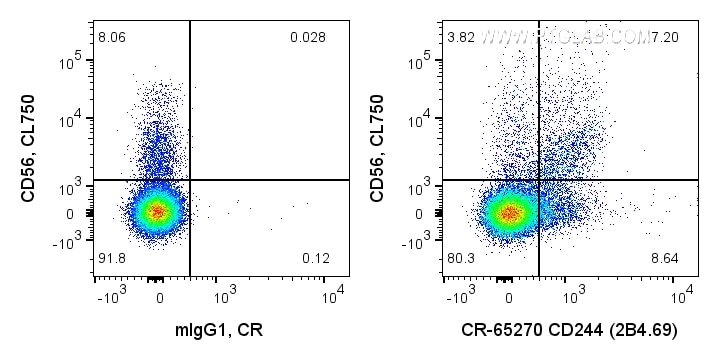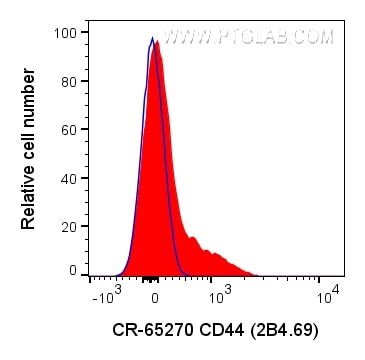Tested Applications
| Positive FC detected in | human PBMCs |
Recommended dilution
| Application | Dilution |
|---|---|
| Flow Cytometry (FC) | FC : 5 ul per 10^6 cells in 100 μl suspension |
| This reagent has been pre-titrated and tested for flow cytometric analysis. The suggested use of this reagent is 5 ul per 10^6 cells in a 100 µl suspension or 5 ul per 100 µl of whole blood. | |
| Sample-dependent, Check data in validation data gallery. | |
Product Information
CR-65270 targets CD244 in FC applications and shows reactivity with human samples.
| Tested Reactivity | human |
| Host / Isotype | Mouse / IgG1 |
| Class | Monoclonal |
| Type | Antibody |
| Immunogen |
N/A Predict reactive species |
| Full Name | CD244 molecule, natural killer cell receptor 2B4 |
| GenBank Accession Number | BC028073 |
| Gene Symbol | CD244 |
| Gene ID (NCBI) | 51744 |
| RRID | AB_3084990 |
| Conjugate | Cardinal Red™ Fluorescent Dye |
| Excitation/Emission Maxima Wavelengths | 592 nm / 611 nm |
| Form | Liquid |
| Purification Method | Affinity purification |
| UNIPROT ID | Q9BZW8 |
| Storage Buffer | PBS with 0.09% sodium azide and 0.5% BSA, pH 7.3. |
| Storage Conditions | Store at 2-8°C. Avoid exposure to light. Stable for one year after shipment. |
Background Information
CD244, also known as SLAMF4 or 2B4, is a type I transmembrane glycoprotein belonging to the signaling lymphocyte activation molecule (SLAM) family. It consists of an extracellular segment with two immunoglobulin (Ig)-like domains, a transmembrane region, and a cytoplasmic domain containing tyrosine-based motifs (PMID: 9841922; 30546369). CD244 is present on natural killer (NK) cells, γδ T cells, a subset of CD8+ T cells, monocytes, basophils, dendritic cells, and myeloid-derived suppressor cells (MDSCs) (PMID: 30546369). It binds to CD48 with high affinity and transmits stimulatory or inhibitory signals that regulate immune function (PMID: 9841922; 18523281).
Protocols
| Product Specific Protocols | |
|---|---|
| FC protocol for Cardinal Red™ CD244 antibody CR-65270 | Download protocol |
| Standard Protocols | |
|---|---|
| Click here to view our Standard Protocols |






